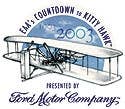
Orville arrived back in camp at Kitty Hawk at 1 p.m. on December 12th, with the new, stronger propeller shafts in hand. The Flyer was reassembled by early the next day. Unfortunately, there was not enough wind to attempt a flight, and the wind was still too light the following day. At 1:30 p.m. on the 14th, they signaled the crew at the U.S. Lifesaving Service Station nearby that they were ready to try a flight and could use a hand. If history was to be made, they wanted an audience. Five men, two small boys and a dog showed up shortly thereafter.
At 2:40 p.m., the Flyer sat tied at the end of the rail, ready to go. The Wrights, however, had made a grave mistake, deciding that rather than fly from the flats near camp, they would take advantage of gravity, laying their rail down on the lower slopes of the big sand hill. Not only would this have compromised any claim to unassisted sustained flight, but the excessive downhill launch speed compounded the difficulties of takeoff and ensured their first try would be a disappointing failure.
|| |---| | | | Wilbur's first attempt ended in a jarring crash.| The Wrights started up the engine … the sudden clatter sending the frightened boys and dog racing out of sight. As the engine warmed up, the brothers stepped off by themselves and flipped a coin. Wilbur won and so earned the right to the pilot's position, climbing into the aircraft as Orville took his position at the right wingtip. Wilbur reached forward to unsnap the clip that held the restraining rope, but nothing happened. The weight of the machine headed even slightly downhill put too much pressure on the release clip for it to open. Quickly, Orville and three of the Lifesavers gently pushed the machine a few inches back, to gain some slack in the line.
Off Wilbur went, with Orville running alongside the machine to steady it as it rode down the rail. Wilbur turned the big front rudder up sharply, but the downhill grade caused the machine to gain speed too quickly, and it rose up in the air about 15 feet, then slowed, stopped and fell back into the sand 60 feet from the end of the rail. The left wingtip struck first, swinging the craft until the front skids hit the soft sand hard enough to break one of the skids, splinter a strut and a brace and a spar in the front rudder. Wilbur was stunned but uninjured, and the propellers continued spinning for a few seconds until he thought to reach forward and shut off the engine. It was all over in three-and-a-half seconds.
Repairs were completed by noon of December 16th, although lack of winds kept them from trying another flight that day. Realizing that the downhill launch was a mistake, the Wrights repositioned their 60-foot launching rail on level ground, just 100 feet from the corner of their shed. In spite of initial failure, the brothers remained confident. Orville wired a terse cable to his father, Milton, and sister Catharine: "Misjudgment at start reduced flight 112 power and control ample rudder only injured success assured keep quiet."
This "Kitty Hawk Moment" is brought to you by the EAA, whose Countdown to Kitty Hawk program, presented by Ford Motor Company, includes an exact flying reproduction of the Wright Flyer. It is the centerpiece of the EAA's national tour during 2003, which will conclude with a five-day celebration at Kitty Hawk, North Carolina, where the Wright Flyer will fly again at exactly 10:35 a.m. on December 17, 2003, commemorating 100 years of powered flight.
www.countdowntokittyhawk.org

Sign-up for newsletters & special offers!
Get the latest FLYING stories & special offers delivered directly to your inbox






